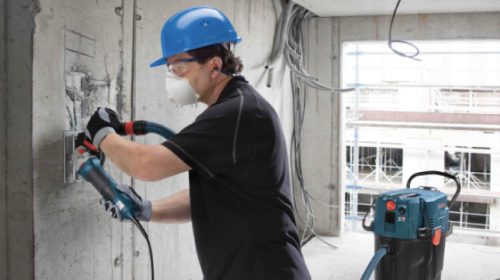The Occupational Safety and Health Administration’s revised protection and monitoring requirements for respirable silica dust exposure in Construction and General Industry workplaces are set, with or without universal employer compliance. Robert Bosch Tool Corp. in Mt. Prospect, Ill., reminds producers and contractors working with concrete, stone or masonry materials of new OSHA requirements in this question & answer with Jim Bohn, director of Strategic Development – North America:
|
|
| Users need to check tool and equipment specs to ensure compliance with silica dust extraction and disposal. |
What if you’re working in a small area where the dust suction attachment won’t fit?
Dust exposure, regardless of the environment, must be controlled. If you’re in an environment where your power tool system is too big, then Table 1 will not be applicable and Paragraph D will take effect. This will require a company to conduct independent testing, with specific documentation on exposure levels and what steps a worker must take to stay below the permissible exposure limit (50 micrograms per cubic meter) over a time-weighted eight-hour day.
Can you use tools from one brand and an attachment from a different brand?
Most brands have attachments that fit their tool(s) due to specific design elements (e.g., rotary hammer tube size variations, collar configuration on a grinder, etc.) Most attachments are brand specific. The exceptions are dust suction drilling attachments and universal collar dust shrouds.
Can a dust extractor (vacuum) from one brand be used with another brand of tools and attachments?
Yes, but you do need to be sure that these three requirements are met: 1) Minimum of 25 CFM per 1 inch of grinder wheel; 2) Filter cleaning system (automatic or semi-automatic); and, 3) 99 percent filtration filter (HEPA is preferred). Also, does a branded tool system require any other specification per the owner’s manual.
What is the proper disposal procedure for concrete dust?
Workers who create respirable silica dust must understand their responsibility in material collection and disposal. It’s highly recommended to use fleece bags. These are usually multi-ply fabric bags that help manage air equilibrium and collect .3- micron or larger dust particles. A fleece bag also contains a port-closing mechanism for containment after removal from the vacuum canister’s port. Finally, it’s strong enough to withstand weight of dust collected and not subject to tearing.
Will there be a special place for users to dispose of a full dust collection bag separate from a regular dumpster?
Take the bag (80 percent full) and place it in a standard garbage dumpster. Be careful that it’s not going to be exposed to potential damage if other items are placed in the same dumpster on top of it. The bag must not break open at any time.
Are HEPA filters required in Table 1?
“HEPA” filters are not required. The OSHA Silica Dust Regulation – Table 1, states that a filter needs to have 99 percent filtration to meet the guideline. Many non-HEPA filters meet this standard, but may not withstand the frequency of dust extractor filter cleaning that’s required due to fineness of silica dust clogging the filter (if not cleaned often). Use a HEPA filter since 1) OSHA agents know its filtration is rated 99 percent effective; 2) it offers greater durability versus a standard filter; and, 3) it saves money in the long term.
Is there a limit for length of a vacuum hose?
Bosch dust extractors can be used with either a 10-ft. hose (which comes with the unit) or a 16-ft. version (sold separately). Beyond 16 feet, the expected efficiency of the dust extractor decreases greatly; users may have dust control performance issues beyond that length.
What about jobsite dust from surrounding work areas? How can this be distinguished from cutting/grinding operations?
Dust generated in and around the jobsite must be compliant with the established control plan for that site. Levels that exceed the dust control plan should be reported immediately. It doesn’t matter who creates the dust, everyone must be safe from exposure.
